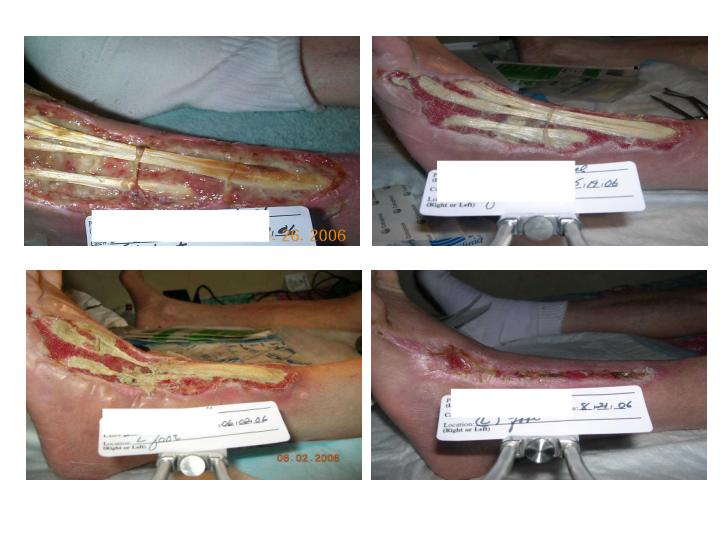Mary Farren, RN, MSN, CWOCN1, Mary Dionson, RN, BSN, CWOCN1, Mollie Mandel, RN, MSN, FNP2, and Avril Dozier, RN3. (1) Visiting Nurse Service of New York, CWOCN, 75-20 Astoria Blvd, Jackson Heights, New York, NY 11370, (2) Visiting Nurse Service of New York, Nurse Educator, 75-20 Astoria Blvd, Jackson Heights, New York, NY 11370, (3) Visiting Nurse Service of New York, COC, 75 -20 Astoria Blvd, Jackson Heights, NY, 11370
Clinical Problem: A 62 y/o male with a history of Type 2 Diabetes admitted to home care with an open wound of the left lower leg measuring 27x7cm s/p surgical debridement for Necrotizing Fasciitis. Albumin 1.9 and A1C 7.8. The patient reported that "the problem began with a small cut on the bottom of his foot near the little toe." The debrided area extended from the left plantar foot 5th metatarsal head up to the anterior lower leg. The wound bed had 90% slough with exposed tendons. The patient lived with his 90 y/o mother in a small apartment that was rodent and moth infested. Description of Past Management: While hospitalized the patient had two surgical debridments, IVAB, NSS w-d dressings and hyperbaric treatments. Current Clinical Approach: Once home, the patient refused hyperbaric treatment stating it made him nervous. The patient acknowledged he did not test his blood sugar regularly and managed his diabetes “his way”. Patient agreed to try negative pressure wound therapy. White foam was used and the periwound was protected with strip paste. The Diabetes CNS recommended a blood glucose monitoring regime for the patient. A nutrition assessment was done and adjustments were made to patients diet to increase protein and vitamins. The patient refused most of the services and recommendations of the social worker but accepted assistance in obtaining disability benefits. “The Setback”: After 3 weeks the wound developed an odor and a MD appointment was arranged. The patient walked the 20 blocks to the MD office and as a result the tendons ruptured. PO antibiotics were ordered and vac therapy continued. Patient Outcomes: After 4 months the wound was brought to full closure. Conclusion: NPWT can be considered a treatment choice for patients with complex social and clinical care management issues.

See more of Case Study Poster Abstracts
See more of Case Study Abstracts
See more of The WOCN Society 39th Annual Conference (June 9 -- 13, 2007)

